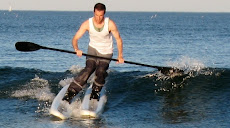
Okay, so the great thing about this kind of debate is to be able to discuss both "sports" that already enjoy an international showing and those that don't. I've decided to address one of those that don't: Tetherball. Give me all your dart players and curlers, and I guarantee they'd hide from a good game of Tetherball.
Tetherball, a favorite on school playgrounds and summer camps in North America looks innocent. But any kid who's gotten a wollop in the head from a tetherball thumped by his opponent at 50 miles per hour will tell you that it's anything but innocent.
Generally, the rules for Tetherball are as follows (courtesy Wikipedia):
The game begins when one player serves the ball, usually by holding it in one hand and hitting it with the other. The opposing player then attempts to return the serve by hitting it in the opposite direction. The object is to hit the ball in such a way that one's opponent will be unable to alter the ball's direction. This gives the server an advantage since the server has more control over the ball from the beginning. It is generally acceptable to hit the ball with either the fist or the open hand.
A player can commit a violation by stepping onto his opponent's half of the pole, by catching and throwing ("carrying") the ball, by striking the rope instead of the ball, or by hitting the ball twice before it has either circled the pole or been returned by the opponent (or, in some variants, struck the pole). Generally, after a violation occurs, the game pauses and the ball is returned to the position it was in before the violation; the number of wraps around the pole is re-created (or a penalty-wrap is awarded to the player who did not commit the foul). The player who did not commit the violation then serves the ball. If, however, the violation appears to be intentional, it may result in loss of game.
The game ends when one player hits the ball around the pole in their own direction as far as it will go, so that the ball hits the pole. In addition, the ball must strike the pole with the final wrap above a line marked on the pole. A five-foot high mark is satisfactory, though a lower mark might be used for younger players. A match can consist of one, three, five, or more games.
A player can commit a violation by stepping onto his opponent's half of the pole, by catching and throwing ("carrying") the ball, by striking the rope instead of the ball, or by hitting the ball twice before it has either circled the pole or been returned by the opponent (or, in some variants, struck the pole). Generally, after a violation occurs, the game pauses and the ball is returned to the position it was in before the violation; the number of wraps around the pole is re-created (or a penalty-wrap is awarded to the player who did not commit the foul). The player who did not commit the violation then serves the ball. If, however, the violation appears to be intentional, it may result in loss of game.
The game ends when one player hits the ball around the pole in their own direction as far as it will go, so that the ball hits the pole. In addition, the ball must strike the pole with the final wrap above a line marked on the pole. A five-foot high mark is satisfactory, though a lower mark might be used for younger players. A match can consist of one, three, five, or more games.
I remember the first time I saw Badminton in the Olympics, where the fly was going at lightning speed over the net. While I still find it boring, I at least have gained respect for it as requiring quickness, strength and hand-eye coordination. Likewise, I remember the first time I saw Tetherball in full action at Camp Tecumseh in Tippecanoe County, Indiana. This made YMCA camp look like bootcamp. Only the best could play and the humiliation or glory that followed a match followed a camper all week. The ball was thumped so hard, flung so high and so fast that only the quick and tall could survive. It flew around that pole as fast as any Olympic Badminton fly over a net, and with a much greater potential for injury. Again, ask any kid who has taken a tetherball to the head. Ouch!
Olympic Tetherball? I think so!




No comments:
Post a Comment